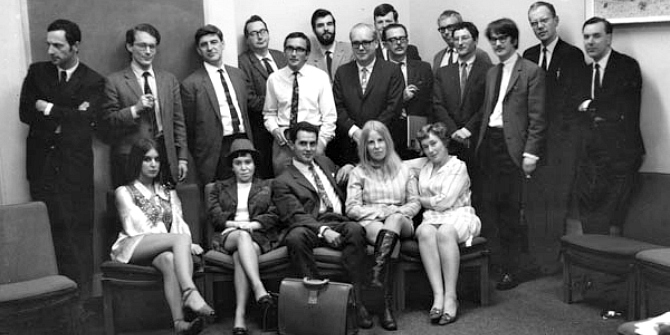
In the Third Edition of Non-governmental Organizations: Management and Development, author David Lewis argues that while management theory and practice have received attention in businesses and government they remain understudied in NGOs. Chandni Singh finds this edition to fill a significant gap of understanding how NGOs function and are managed in an increasingly complex global environment.
Non-governmental Organizations: Management and Development, 3rd Edition. David Lewis. Routledge. 2015.
Non-governmental organisations (NGOs) are undisputedly important actors in global development. From being charities that raise funds to agents of advocacy for the marginalized, NGOs span multiple roles. Recent debates on the legitimacy of NGOs, lack of financial transparency and inefficiency in crisis conditions (caricatured as the ‘humanitarian circus’) have highlighted the importance of interrogating how NGOs function and the implications of this in their outputs. David Lewis’s book Non-governmental Organizations: Management and Development tackles this question by offering important insights into the complex, messy context NGOs operate in and unravelling these implications on their management and outputs.
The book begins by presenting the complex and often contentious environment NGOs operate in and provides a conceptual framework to explore NGO management. The second part of the book interrogates how and why NGOs have become crucial actors in global development and reports the different management challenges NGOs face. Lewis then moves on to illustrate the practice of NGO management. Using illustrative cases, he highlights how external factors such as managing relationships with actors such as the state, private sector and local communities, and internal dynamics, such as organisational ambition curves and practices of working, temper NGO management.
Lewis sets the stage by arguing that while management theory and practice have received attention in businesses and government they remain understudied in NGOs. He notes that NGOs face management issues because of the nature of activities they undertake, the organizational space they occupy, the relationships they have or don’t have, and crucially, the complex contexts they are embedded in. This larger context is increasingly complex and difficult to negotiate, making management of such organisations inherently difficult. This focus on understanding the context within which NGOs operate is where Lewis’s expertise in anthropology and his rich experience with NGOs makes the book’s arguments compelling.
In Part II, Lewis begins by summarising how the evolution of development theory has shaped the practice of development and subsequently, the roles that NGOs undertake. In doing so, he sheds light on how NGO-donor relations have also evolved leading to different roles and management styles NGOs take on. These roles fall under three types: implementers, catalysts, and partners. Temporally, as NGOs grow and change, their leadership systems function differently, in order to negotiate multiple activities and identities. Occupying the fuzzy space between the bureaucratic world (hierarchical and specialised) and other ‘associational’ worlds (complex, informal and multi-faceted), NGOs have to be creative to hold onto their values while leveraging their goals.

Having established the context within which NGOs operate, it is in Part III that Lewis finally turns to the practice of NGO management. Using cases, Lewis demonstrates how the multiple relationships NGOs manage (e.g. with local communities and government, businesses and other development agencies) are characterised by unequal power relations, differing agency, donor requirements etc. For example, with other development agencies, NGOs negotiate issues of unequal power (international agencies often act as funders while contracting implementation to local NGOs) and coordination (which is undermined by competition for limited funds). Also, managing these relationships effectively requires a clear strategy and resource allocation. While the illustrative examples from research and practice are presented to show the plurality of management systems in NGOs, how this can be negotiated to improve day-to-day NGO management is not explicitly discussed. A clear idea of how the book’s findings can translate into the practice of NGO management and directions for development professionals would have been valuable for readers.
Emphasis is also placed on the fact that NGOs also have to manage relationships internally (Chapter 11) where they have to deal with often unclear organisational objectives, monitoring and evaluation challenges, difficulties in balancing donor priorities and stakeholder expectations, and maintaining staff passion while responding to the increasing pressures to professionalise an inherently informal and flexible system. Discussing the importance of strong leadership, clear organisation strategy, capacity building of staff and better information management, Lewis notes that there is still insufficient agreement on the fact that ‘fixing’ internal management is a critical factor in making NGOs work more efficiently. This insight is of importance in a fast evolving development sector and adds to previous suggestions that NGOs are spaces of power, contestations, and hierarchies that must be recognised, managed and negotiated (Chambers and Pettit, 2013).
Non-governmental Organizations: Management and Development is a critical book which fills a significant gap – that of understanding how NGOs function and how they are managed. While Lewis uses development theory, anthropology, organisational theory and management studies to highlight the key changes and events shaping development NGOs’ work and management, at times the book seems too wide in its scope while the focus on how NGOs work and are managed gets obscured. However, as someone who has worked in and with NGOs, the book was a valuable and engaging read and helped me appreciate the complex and highly contradictory worlds development NGOs work in.
In the context of continued reliance on NGOs to deliver development interventions, this book’s key contribution – the importance of pluralistic management for development NGOs – is timely and significant. The book’s findings and extensive reference list will find use for development practitioners, researchers and students.
Chandni Singh is a postdoctoral researcher at the Indian Institute of Human Settlements, Bangalore. She has done her PhD in Rural Livelihoods from the University of Reading, UK and her masters in Natural Resource Management from TERI University, India. Chandni has worked with several NGOs on projects related to climate change adaptation, livelihood diversification, and community-based resource management. She blogs at Village Vignettes and tweets @_chandnisingh.








1 Comments